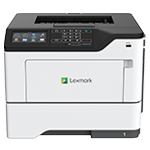
Lexmark MS622
Funciones de la impresora: láser, únicamente impresión, blanco y negro
Visión general
Nuestra página de manuales y guías interactivas ofrece artículos de conocimientos básicos, así como guías de usuario para ayudarle a instalar, configurar, mantener, solucionar problemas y reciclar su producto.
Puede encontrar contenido adicional disponible para descargar en otros formatos e idiomas en nuestra página de guías descargables.
Para obtener información sobre la seguridad, el medio ambiente y las regulaciones de su producto, consulte nuestra sección de Seguridad y avisos de nuestras guías descargables.